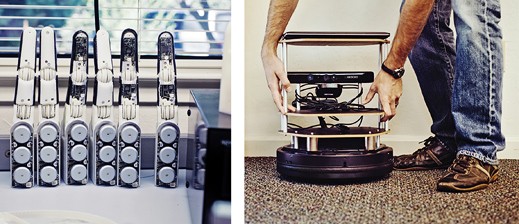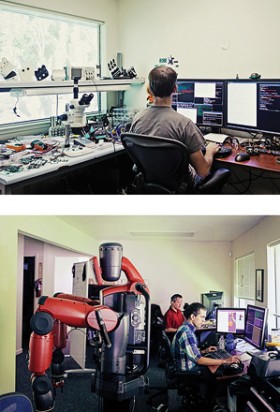
` Morgan Quigley, 32
Open-source software is making it nearly as easy to program a robot as it is to write an app.
Three decades ago, the availability of many versions of DOS helped spark the boom in personal computers. Today, Robot Operating System, or ROS, is poised to do the same for robots. Morgan Quigley programmed the first iteration of what grew into ROS as a graduate student in 2006, and today his open-source code is redefining the practical limits of robotics. Since version 1.0 was released in 2010, ROS has become the de facto standard in robotics software.
To visit Quigley’s office at the Open Source Robotics Foundation in Mountain View, California, the organization he cofounded last summer to steward ROS, is to step into a future of robotics where hardware is cheap, and it’s quick and easy to snap together preëxisting pieces to create new machines. Quigley’s workspace is littered with dozens of mechanical fingers—modules that form a robotic hand. “The hands themselves can talk ROS,” Quigley says. His T-shirt is emblazoned with a programming joke: shirtcount++;.
Unlike more conventional robotic technology, Quigley’s four-fingered hand is not controlled by a central processor. Its fingers and palm distribute computing chores among 14 low-cost, low-power processors dedicated to controlling each joint directly. That greatly simplifies the internal communication and coördination required to execute a task such as picking up a pencil. Both the software and electronics are open source. Any robot builder can take Quigley’s design and use or improve upon it.

Ultimately, Quigley hopes, these innovations will lead to more agile, more capable robots that can perform a variety of jobs and don’t cost tens or hundreds of thousands of dollars. And no longer will engineers have to start from scratch to design the functions that go into a robot—they’ll have an open-source base of code and hardware. Already, engineers using ROS are working on robots that do everything from folding laundry to repetitive operations in advanced manufacturing. “It will allow applications we couldn’t dream of before,” Quigley says.
Masterstroke
Unlike many children of the 1980s and 1990s, Quigley wasn’t enthralled by Star Wars’ C-3PO or Star Trek: The Next Generation. Rather, he was mesmerized by the far more mundane but real Apple II computer at his elementary school. In class, he typed commands in the Logo language to move an animated turtle around the screen—the ancestor of ROS’s turtle mascot. But it wasn’t until 1998, when he entered Brigham Young University in Provo, Utah, that he encountered robots. He was hooked. “Robots are the meeting place between electronics, software, and the real world,” he says. “They’re the way software experiences the world.”
When he arrived at Stanford for graduate study in machine learning, Quigley joined Andrew Ng’s lab, where the students were collaborating on the Stanford Artificial Intelligence Robot, or STAIR. Typical industrial robots execute a single tightly defined task in a controlled environment, like an advanced automobile factory. Ng, however, envisioned a general-purpose robot that could execute diverse tasks in an uncontrolled environment. The signature STAIR challenge was getting the robot to respond productively to the request “Fetch me a stapler.” To bring back the stapler, STAIR needed to understand the request, navigate hallways and elevators to an office, open the door, make its way to the desk, identify a stapler among other items of roughly the same size, pick it up, bring it back, and hand it off.
As Ng’s teaching assistant, Quigley realized that the class needed a software framework that could integrate contributions from a few dozen students working asynchronously without bringing down the robot when one of their programs crashed. ROS was his solution: a distributed peer-to-peer system designed to connect all the resources—technological and human—required to make a robot work.

In 2007, he began collaborating with Willow Garage, a Silicon Valley company that works on robots and open-source software. For the next two years, Quigley oversaw the ROS architecture while Willow Garage’s programmers extended his initial work. Released in 2010, ROS quickly became the dominant software framework for robotics.
Despite its name, ROS isn’t really an operating system. It’s a framework that enhances conventional operating systems (theoretically, any OS; in practice, Linux). It provides software modules for performing common robotics functions such as motion planning, object recognition, and physical manipulation. So if you want a robot to map its surroundings, you don’t have to write that code; you can simply plug in the ROS software module. As an open-source product that can be freely modified, it attracts a community of users who are constantly improving and extending its capabilities.
Any number of independent modules can run at a given time. Modules can be connected for testing, disconnected for debugging, and reinstated without destabilizing the network as a whole. In this way, ROS allows a robot to be controlled by any number of computers running any number of programs—a laptop focusing on navigation, a server performing image recognition, an Android phone issuing high-level instructions. It all happens in real time as the robot wanders about.
The masterstroke in Quigley’s design is not strictly technical but social. Members of the community who produce a finished release can distribute it themselves, rather than having to house it on central servers. “That’s a big deal in terms of giving people the credit they deserve and allowing them to control their contributions,” Quigley says. “Their code isn’t lost in this beast called ROS.”
Grand Plan
Quigley’s ambition is to make ROS a productive starting point for any kind of robotic system—large or small, expensive or cheap, academic or commercial, networked or stand-alone.

Adapting ROS for low-cost processors is critical if the software is to play a key role in next-generation designs. Cheap processors are becoming more capable, opening an opportunity to bring the intelligence that has been concentrated in desktop-class processors to the CPUs that manage robotic wheels, joints, and cameras. Where image recognition was once a function of a rack of servers, soon it might be managed within the camera.
Quigley also wants ROS, which was designed to control one robot at a time, to move into environments that use multiple robots. Settings such as warehouses or factory floors would benefit from squadrons of them operating in a coördinated way. Beyond that, it’s not hard to imagine robot fleets managed in the cloud: users could send ROS commands to a data center and from there to an automaton. “ROS might tie into an online knowledge base,” Quigley says, “so if someone says, ‘Get the stapler off my desk,’ it might retrieve a CAD model of a stapler from the cloud.”
—Ted Greenwald
